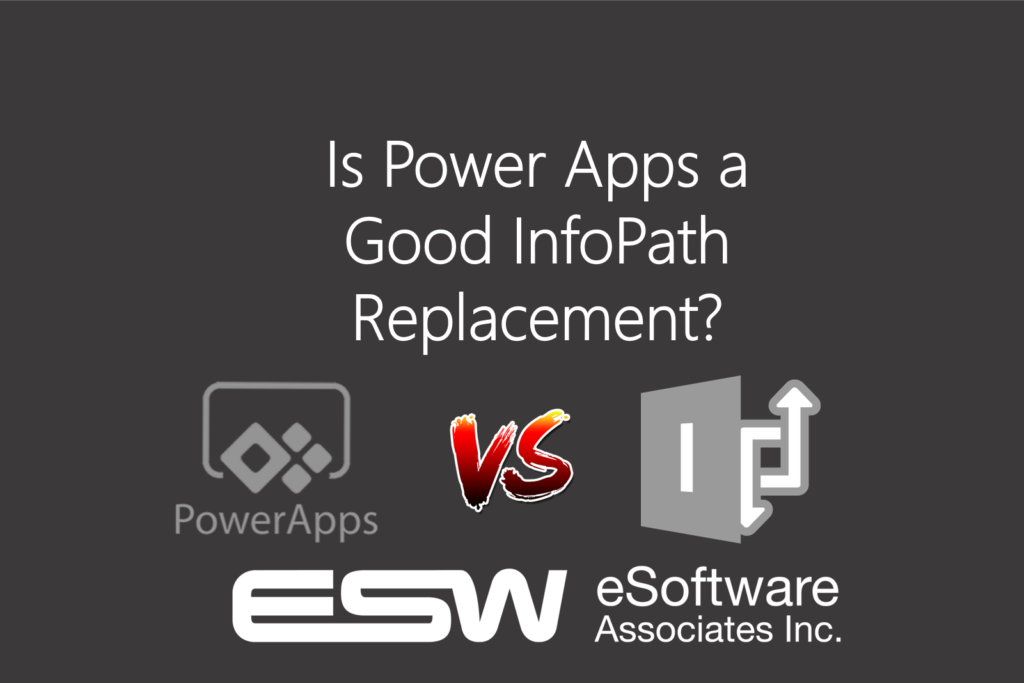How to Migrate from InfoPath to Power Apps
Interested in migrating from InfoPath to Power Apps, but finding that there aren’t many good articles explaining the differences? We have you covered. This article describes what both technologies are, what they are good at and what to look out for before attempting to do the migration. There are a lot of differences between the two technologies and requires a solid technical understanding of each. Microsoft Power Apps is a great InfoPath replacement, but you should be aware of their differences.
InfoPath is a tool that lets you create forms and gather data in order to streamline your business processes. InfoPath also requires no code to get started, and developers can create advanced forms as well—including composite applications and workflow sequences. Infopath can be downloaded here.
Power Apps is a suite of apps, services, connectors and data platform that provides a quick way to build custom apps for your business needs. These apps connect to your business data stored both in the underlying data platform or in various online and on-premises data sources (SharePoint, Excel, Office 365, Dynamics 365, SQL Server, and so on).
All apps built with Power Apps require no code, have a responsive design, and can run in any browser—including mobile.
Great! Can I migrate from InfoPath directly into Power Apps?
Unfortunately, no. Everything you have in InfoPath forms will have to be remade from scratch in Power Apps. Below is a Microsoft Ignite session that will help you get started.
So does Power Apps do everything InfoPath did?
Also, no. Power Apps still has some limitations that keep it from fully replacing InfoPath—hence the InfoPath support until 2026, as Microsoft needs time to keep adding features that will allow Power Apps to do so.
What do they have in common?
In terms of desktop clients, both InfoPath Forms and Power Apps have desktop clients, with InfoPath’s support ending in 2026. Both can be used to create Apps for the web, but Power Apps has more limitations at the moment.
In mobile support, while InfoPath lets you design templates for Mobile, these have to be custom-made. Power Apps, on the other hand, offers native creation of mobile apps—which can be later installed on mobile devices, be it cell-phones or tablets.
Both InfoPath and Power Apps have the drag and drop functionality to attach and drag SharePoint List items from one column to another. PowerApps has this simplified, however, and it’s easier to drag and drop items in order to increase visual interest in your forms.
InfoPath lets you connect to many external sources to display data on a form, and so does Power Apps through the use of Connectors.
Offline capability is also offered on both services. This enables users with limited network capabilities to fill out template-based forms based on the Offline template. While InfoPath will let you configure a form’s template to cache data locally, Power Apps enables local collections for data management without changing the app.
What does InfoPath have that Power Apps doesn’t?
Custom Code is where InfoPath still has the upper hand, as it lets you create templates that have business logic coded in C# or VB. Power Apps does this all without enabling managed code, which does limit the most advanced options.
Another aspect where InfoPath is ahead is external user autonomy. InfoPath lets anonymous users submit data to a SharePoint list, whereas this capability isn’t available in Power Apps yet.
Finally, there’s the matter of XML as a data source. InfoPath lets you design and create forms that deal with structured XML documents—but this isn’t supported by Power Apps yet.
If you InfoPath replacement needs any of the above, you may need to consider another tool such as Nintex forms.
What’s easier to do on Power Apps?
Adding conditional logic to your forms, for instance. Although InfoPath lets you do this, Power Apps does that, and more. Not only does it let you show/hide columns, you can also change colors, spacing, etc. While the controls aren’t quite the same, Microsoft will keep on working to make logic within Power Apps easier, and once you learn how to add conditionals, it’s extremely simple to do it again.
It’s also very easy to use Power Apps with SharePoint on-premises if you’ve been assigned a license. You can then install the “On-Prem Gateway” on your SharePoint and use it to access all your information in SharePoint.
Power Apps can also replace your normal SharePoint list form. It is, however, only enabled in the “Modern” SharePoint experience. If you’re using Modern for lists, all you have to do is go to your List Settings, then Form Settings, and choose “Use a custom form in Power Apps.” After you customize that Power Apps form, it will automatically save back to the list. This lets you have new and customized view/edit forms just like InfoPath.
Should Power Apps by Our InfoPath Replacement?
Although you still have a few years to use InfoPath, the app will no longer be supported after 2026. You can still use InfoPath until then, of course, but the sooner you begin moving to its replacement, Power Apps, the better.
It sounds daunting, but your InfoPath replacement with Power Apps can greatly streamline your processes.

